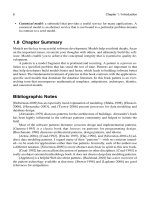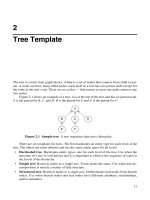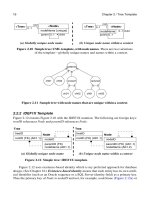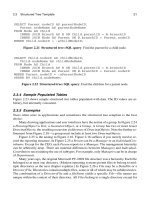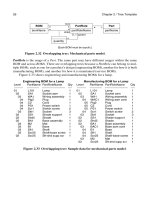PATTERNS OF DATA MODELING- P36 ppt
Bạn đang xem bản rút gọn của tài liệu. Xem và tải ngay bản đầy đủ của tài liệu tại đây (146 KB, 5 trang )
162 Chapter 12 / Language Translation
The translation service is dedicated software that runs apart from client applications.
The translation database stores corresponding Phrases for various Languages and Abbrevi-
ationTypes. (A person must populate the translation database.) Upon request, the service
finds the translation given a source Phrase, target Language, and target AbbreviationType.
Figure 12.4 shows a sample application table that could be subject to the translation
mechanism. The phrase–to–phrase approach has a language bias. For example, the source data
may be stored in English and converted to another language only upon translation mapping.
Architecturally, a language bias is undesirable because users may detect the favored language.
The pseudocode in Figure 12.5 illustrates the logic for finding a translation. (The
pseudocode is written using the UML’s Object Constraint Language [Warmer-1999].) The
basic logic is to first look for an exact match to the target language. Otherwise, if a Dialect
is specified, look for the corresponding MajorLanguage. If that fails, then make one more
try to look for the AllLanguage record.
Figure 12.3 Phrase–to–phrase translation: IDEF1X model.
languageDiscrim
languageID
Language
languageName (AK1.1)
languageDiscrim
MajorLanguage
majorLanguageID (FK)
allLanguageID (FK)
Dialect
dialectID (FK)
majorLanguageID (FK)
AllLanguage
allLanguageID (FK)
phraseID
Phrase
string
phraseEquivalenceID (FK) (AK1.1)
languageID (FK) (AK1.2)
abbreviationTypeID (FK) (AK1.3)
abbreviationTypeID
AbbreviationType
abbreviationTypeName (AK1.1)
phraseEquivalenceID
PhraseEquivalence
Person
personalName
birthdate
birthPlace_English
familyName
hairColor_English
eyeColor_English
height
weight
Figure 12.4 Phrase–to–phrase translation: Person model.
12.4 Language–Neutral Translation 163
12.4 Language–Neutral Translation
Figure 12.6 and Figure 12.7 show a model for a language–neutral translation service. This ap-
proach separates the multiple meaning of words and phrases for a clean translation. However,
you replace translatable strings with concepts IDs, limiting this approach to new applications.
A Phrase is a string with a specific Language and AbbreviationType. The Language for
a string can be a Dialect, a MajorLanguage, or AllLanguage. A MajorLanguage is a natural
language, such as French, English, and Japanese. A Dialect is a variation of a MajorLan-
guage, such as UK English, US English, and Australian English. AllLanguage has a single
record for strings that do not vary across languages.
Each Phrase has an AbbreviationType which is the maximum length for a string. For
example, a name may be short (5 characters), medium (10 characters), long (20 characters),
and extra long (80 characters). Abbreviations are especially handy for reports and forms.
Phrase::getTargetPhrase (aTargetAbbrevType, aTargetLanguage) RETURNS aPhrase
/* Start with all possible phrases for a source Phrase */
aSetOfPhrases := self.PhraseEquivalence.Phrase
/* Second, restrict phrases to matching the target abbreviation type */
aSetOfPhrases := aSetOfPhrases->SELECT (abbreviationType == aTargetAbbrevType)
/* Third, look for an exact match to the target language */
card := Cardinality (aSetOfPhrases=>SELECT(language==aTargetLanguage));
IF card == 1 THEN RETURN aSetOfPhrases->SELECT(language == aTargetLanguage)
ELSEIF card > 1 THEN RETURN "Error: Ambiguous"
ENDIF
/* Otherwise for a dialect look for a major language */
IF TypeOf(aTargetLanguage) == "Dialect" THEN RETURN
self.getTargetPhrase (aTargetAbbrevType, aTargetLanguage.MajorLanguage);
ENDIF
/* Otherwise for a major language look for a default */
IF TypeOf(aTargetLanguage) == "MajorLanguage" THEN RETURN
self.getTargetPhrase (aTargetAbbrevType, aTargetLanguage.AllLanguage);
ENDIF
/* Else failure. Could not find a translation. */
RETURN "Error: No translation found"
END getTargetPhrase
Figure 12.5 Phrase–to–phrase translation: Pseudocode for finding a phrase.
164 Chapter 12 / Language Translation
Figure 12.6 Language–neutral translation: UML model. Consider for
new applications that require a robust translation approach.
Language
name {unique}
*
1
*
1
Dialect MajorLanguage AllLanguage
Phrase
string
1
*
TranslationConcept
*
1
AbbreviationType
name {unique}
*
1
ConceptEquivalence
*
1 0 1
1
preferredConcept
{TranslationConcept + AbbreviationType + Language is unique.}
Figure 12.7 Language–neutral translation: IDEF1X model.
languageDiscrim
languageID
Language
languageName (AK1.1)
languageDiscrim
MajorLanguage
majorLanguageID (FK)
allLanguageID (FK)
Dialect
dialectID (FK)
majorLanguageID (FK)
AllLanguage
allLanguageID (FK)
phraseID
Phrase
string
translationConceptID (FK) (AK1.1)
languageID (FK) (AK1.2)
abbreviationTypeID (FK) (AK1.3)
abbreviationTypeID
AbbreviationType
abbreviationTypeName (AK1.1)
translationConceptID
TranslationConcept
conceptEquivalenceID (FK)
conceptEquivalenceID
ConceptEquivalence
preferredConceptID (FK) (AK1.1)
12.4 Language–Neutral Translation 165
A TranslationConcept is the idea in a person’s mind that underlies a group of related
Phrases. The premise of language–neutral translation is that an idea can be precisely ex-
pressed in any Language. Of course, this assumption is not exactly true as each language has
its nuances. However, it is a good approximation for translating short phrases such as those
that occur in user interface screens and reports. The translation service is not intended for
long passages such as those in documents and books.
Table 12.2 shows a simple example. A person has the concept “truck” in mind with a
translationConceptID of 2054.
•A MajorLanguage of English and long AbbreviationType yields a Phrase of “truck.”
•A MajorLanguage of French and long AbbreviationType yields a Phrase of “camion.”
•A MajorLanguage of English and short AbbreviationType yields a Phrase of “trk.”
•A Dialect of British English and long AbbreviationType yields a Phrase of “lorry.”
In practice, many persons could populate data and define redundant TranslationConcepts.
Multiple definitions are undesirable but difficult to avoid. These multiple definitions ripple
throughout application databases and are difficult to consolidate.
ConceptEquivalence provides a cross reference for synonymous TranslationConcepts
and effects a logical merge. (See Chapter 11.) The application tables store translationCon-
ceptIDs. ConceptEquivalence serves only as a cross-reference and is not referenced by ap-
plication tables. (See the Symmetric relationship antipattern in Chapter 8.) Each occurrence
of ConceptEquivalence has a preferred TranslationConcept.
The translation service is dedicated software that runs apart from client applications. To
use the service, an application database substitutes a translationConceptID for each translat-
able phrase. For each TranslationConcept, the translation database stores the corresponding
Phrases for the pertinent Languages and AbbreviationTypes. (A person must populate the
translation database.) Upon request, the service finds the Phrase for the specified Transla-
tionConcept, Language, and AbbreviationType.
Figure 12.8 shows a sample application table that is subject to language–neutral trans-
lation. The use of concept IDs works well for a new application. But it would be disruptive
for an existing application to change strings to IDs.
The pseudocode in Figure 12.9 illustrates the logic for finding a phrase, given a Trans-
lationConcept, AbbreviationType, and Language. The basic logic is to first look for an exact
translationConceptID Language AbbreviationType Phrase
2054
MajorLanguage = English long truck
MajorLanguage = French long camion
MajorLanguage = English short trk
Dialect = British English long lorry
Table 12.2 Language–Neutral Translation: Sample Phrases
166 Chapter 12 / Language Translation
match to the target language. Otherwise, if a Dialect is specified, look for the corresponding
MajorLanguage. If that fails, then make one more try to look for the AllLanguage record.
Person
personalName
birthdate
birthPlace_conceptID
familyName
hairColor_conceptID
eyeColor_conceptID
height
weight
Figure 12.8 Language–neutral translation: Person model.
Figure 12.9 Language–neutral translation: Pseudocode for finding a phrase.
TranslationConcept::getPhrase (aTargetAbbrevType, aTargetLanguage)
RETURNS aPhrase
/* Start with all possible phrases for a TranslationConcept */
aSetOfPhrases := self.ConceptEquivalence.preferredConcept.Phrase
/* Second, restrict phrases to matching the target abbreviation type */
aSetOfPhrases := aSetOfPhrases->SELECT (abbreviationType == aTargetAbbrevType)
/* Third, look for an exact match to the target language */
card := Cardinality (aSetOfPhrases=>SELECT(language==aTargetLanguage));
IF card == 1 THEN RETURN aSetOfPhrases->SELECT(language == aTargetLanguage)
ELSEIF card > 1 THEN RETURN "Error: Ambiguous"
ENDIF
/* Otherwise for a dialect look for a major language */
IF TypeOf(aTargetLanguage) == "Dialect" THEN| RETURN
self.getPhrase (aTargetAbbrevType, aTargetLanguage.MajorLanguage);
ENDIF
/* Otherwise for a major language look for a default */
IF TypeOf(aTargetLanguage) == "MajorLanguage" THEN RETURN
self.getPhrase (aTargetAbbrevType, aTargetLanguage.AllLanguage);
ENDIF
/* Else failure. Could not find a translation. */
RETURN "Error: No translation found"
END getPhrase



